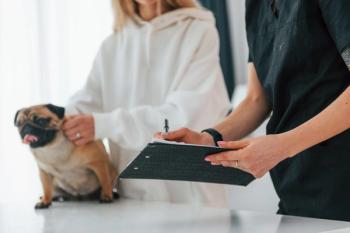
Survey: Wage disparity unabated, educational debt continues climb
Las Vegas - Fresh out of college, Dr. Carlos Vareli earns $72,000 a year and pays on $75,000 in education loans.
LAS VEGAS — Fresh out of college, Dr. Carlos Vareli earns $72,000 a year and pays on $75,000 in education loans.
That salary puts the Tuskeegee University alumnus in line with just 2 percent of the 1,773 2006 graduates who participated in the American Veterinary Medical Association's (AVMA) annual salary and debt survey. When it comes to student loans, Vareli's balance mirrors the debt of nearly 17 percent of the nation's newest DVMs. According to the study, published in the Oct. 1 issue of the Journal of the American Veterinary Medical Association (JAVMA), 45 percent of his classmates surveyed owe $100,000 or more.
Yet Vareli's good fortune doesn't end here. According to additional AVMA survey results released Oct. 15 in JAVMA, the small animal practitioner also out-earns his female counterparts. While starting salaries and benefits rose across-the-board, they increased more for male DVMs. The mean starting salary in 2006 for males in private practice totaled $56,772 while females went to work for $2,000 less.
Vareli offers no explanation for the inequity: "I think I'm making more than average compensation-wise, and compared to female graduates, that just doesn't make sense."
Overlooked factors
Dr. Michael Reardon, director of admissions for Virginia-Maryland Regional College of Veterinary Medicine offers a few ideas. Economics aside, the study, he says, fails to account for intangible factors that might offer insight on why a female graduate might choose a job. Although the survey reports 28.1 percent of male graduates receive individual retirement account benefits versus 22.1 percent of female graduates, women in the study might not have held out for more fringe benefits due to flexibility, location or relationship issues.
Fast Fact (Source: American Veterinary Medical Association)
"I think the intangibles are one of the things we wrestle with when doing these types of surveys," he says. "What are the other reasons they took the job, outside of money? There's no reason why women can't earn what men do from an education and competency standpoint."
Furthermore, the numbers might be skewed based on the salaries of large animal exclusive practitioners, which most often are men and rank the highest earners with mean starting salaries of $63,351. Nearly 38 percent of the female respondents chose employment in small animal exclusive practices — compared to 25 percent of male respondents — earning mean starting salaries of $56,654.
Inequity explanation
Still, male respondents in small animal exclusive practice earned more than their female counterparts by roughly $3,000. Faced with the apparent inequity, Reardon admits there appears to be some social, possibly inherent, differences between the genders.
Simply put: Men demand more, he says.
"Part of it is women seem to have a harder time asking for more professional compensation," he says. "I don't understand why because it's a female-dominated pool of employees right now. All the women have to do is hold out for it. It's not like they're going to find a guy to take the job; they're 85 percent of the graduating class. I just don't think they push as hard as they can."
Another reason why the study's numbers tilt in mens' favor is more women take part in their spouses' insurance programs, forfeiting their own and making their salary packages appear less, he adds.
Comparative findings
Dr. Don Klingborg, associate dean for public programs and director of the University of California Davis' (UC-Davis) Veterinary Medicine Extension Department, says AVMA's results mirror results from a survey he conducted of California practitioners in the late 1990s, which drills more in-depth than the association's report. While women in their first years out of college earned less than men, the disparity leveled off after a decade in practice, Klingborg contends. With the number of women in veterinary medicine statistically insignificant beyond 10 years, only the men were tracked, showing their earnings falling after 15 years in practice.
"It's only speculation, but we think women were engaged in family care early on and didn't come back to working full time until later in their careers," he says. "Men tend to reverse that. They work harder earlier on and then start to play more, discovering golf or boats."
The UC Davis study boosts Klingborg's assessment, revealing no gender differences in ability to charge clients and productivity levels based on hourly rate. While women reportedly worked fewer hours and men took more emergency weekend and night cases, productivity levels remained on par for both genders during the day. "Our assumption: Women needed more flexibility and security," he says.
Women carry more debt
Klingborg offers no trend data when it comes to gender disparity in educational debt. Yet Reardon, who's watched veterinarians' salaries and debt rise for 15 years, says the AVMA's survey results offer no surprises, including the fact that women reportedly hold more educational loans then their male counterparts in veterinary medicine. Out of 1,750 respondents, 65.7 percent reported debt greater than $80,000. Mean debt increased 13.5 percent from 2005 to 2006, rising to $100,805. By comparison, debt increased 9.6 percent from 2004 to 2005.
The gender breakdown reveals mean debt was $95,486 for male veterinarians versus $102,420 for females.
Reardon chalks the difference up to greater preparedness among male students. Of those who accumulated no debt, men made up .2 percent more of the survey's 2006 graduate respondents, totaling 11.5 percent.
"I'm not shocked by that finding," he says. "Many of the men who come in have appeared to plan ahead more. We're probably seeing that men have worked a little more, and that purely might be what it is. Everyone's tuition is the same. It's about how much it costs a student to live in a way he or she is comfortable with."
That's a reach, Klingborg says, opining that female veterinary students work equal to their male counterparts outside of the academic setting.
Advanced study issue
He also pokes holes in the AVMA study's salary interpretation.Emerging trends in new graduate earnings such as signing bonuses, relocation money and production pay are murky within AVMA's numbers, Klingborg says.
"You can argue that those perks should be counted in any salary survey, and I can't tell from AVMA numbers if anyone is factoring that in," he says. "The graduates themselves can't predict how much they're worth when it come to production pay."
According to AVMA survey results, 2006 graduating veterinarians in all employment types earn $45,546 — a far cry from large animal and uniformed service practitioners who command roughly $60,000 a year. While 78 percent of the 2006 graduating class responded to AVMA's survey, a disproportionate number of respondents in the advanced study category drove numbers lower, Reardon contends. Results show those in advanced study earn a mean salary of $25,496.
"One out of three people reported in the survey were in that category," he says. "I think that's high if you looked at the class that graduated and stems from the fact that those in advanced study were more likely to fill out the survey questionnaire."
Yet Klingborg points to 42 percent of UC Davis' graduating class continuing on to advanced study, which he agrees skews the salary numbers low.
Still, while AVMA shows small animal exclusive graduates earn roughly $57,000 a year, 2006 UC Davis graduates earn $64,500 annually. That rises to roughly $84,000 by including $8,245 in the new employees' bonuses and other compensation.
"That's a huge jump when you consider all these new graduates are reported to receive: sick leave, insurance, dues, benefits, housing and, in some cases, a vehicle," Klingborg says. "I think our market is different out here; there is no question there are regional differences. But without additional data, it's challenging to interpret exactly what AVMA means."
Newsletter
From exam room tips to practice management insights, get trusted veterinary news delivered straight to your inbox—subscribe to dvm360.






